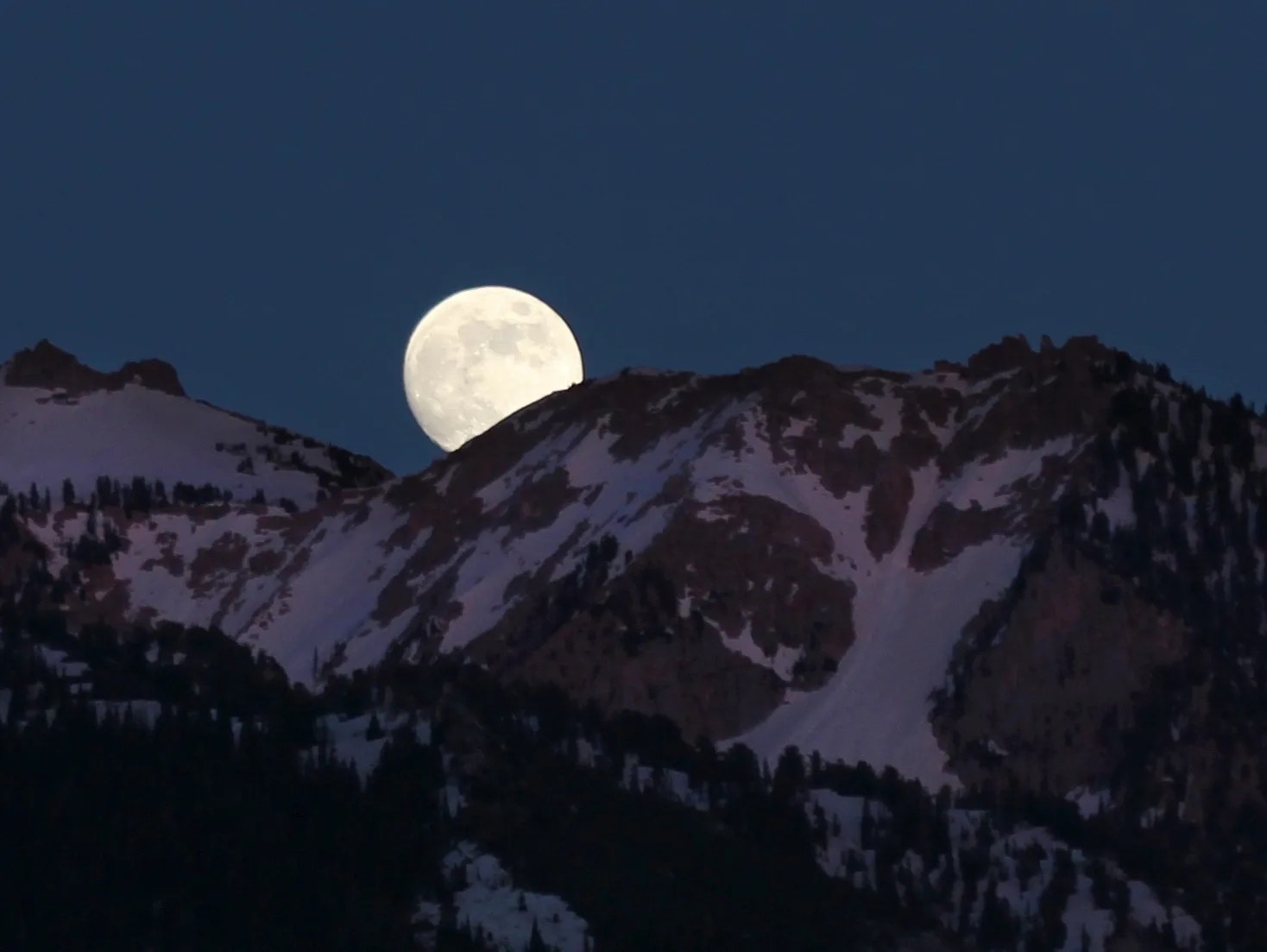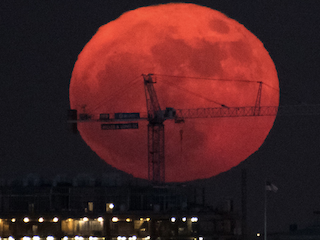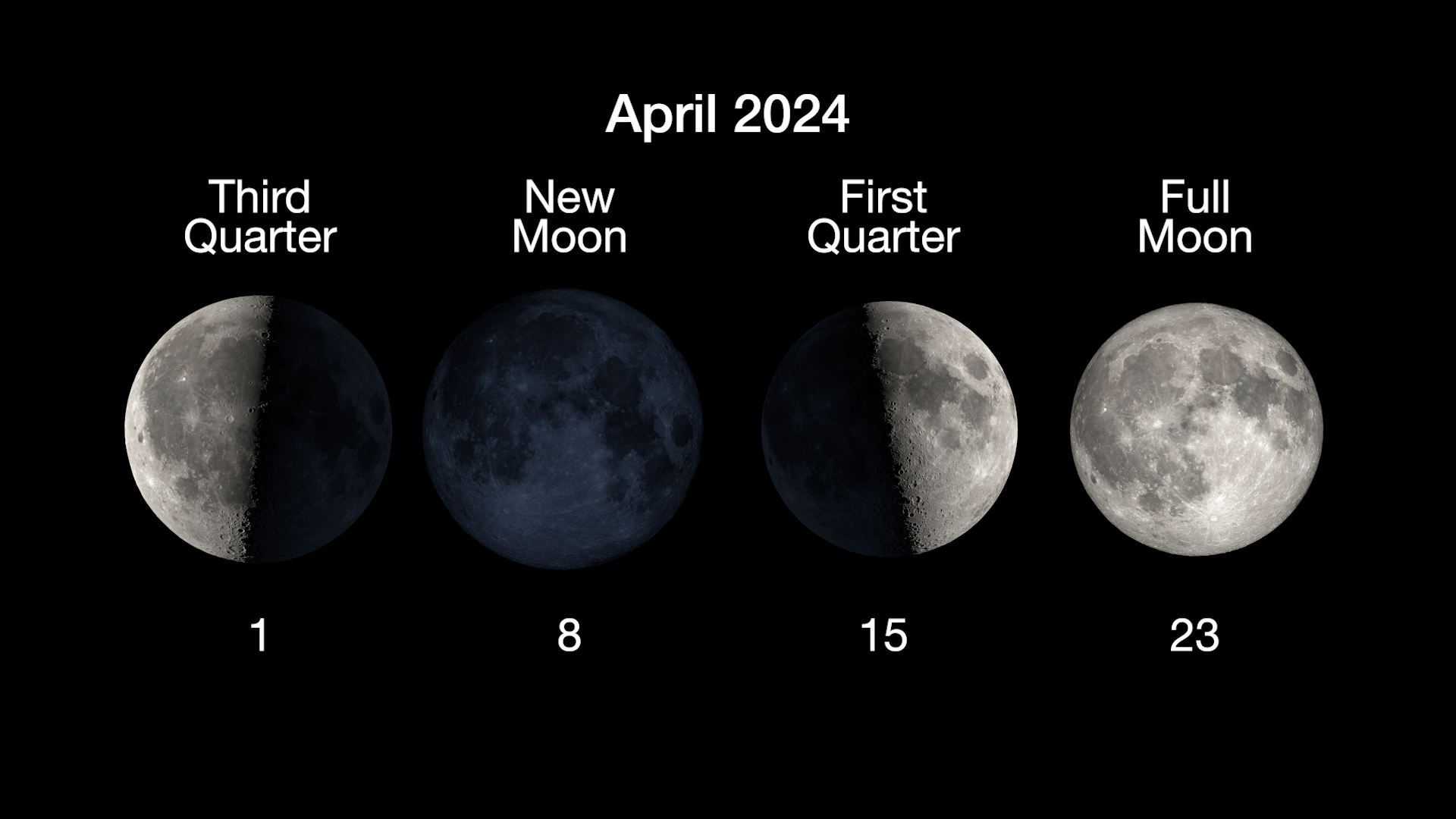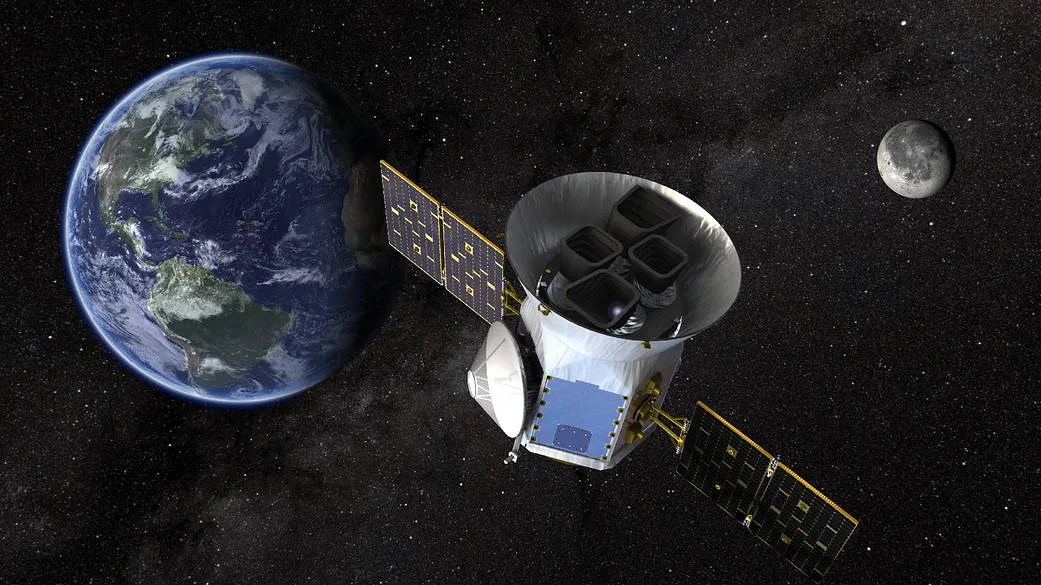18 min read

The next full Moon is the Pink Moon, Sprouting Grass Moon, Egg Moon, Fish Moon, the Pesach or Passover Moon, Paschal Moon, Hanuman Jayanti, Bak Poya and a "supermoon."
The Moon will be full on Tuesday night, April 7, 2020, appearing opposite the Sun (in Earth-based longitude) at 10:35 PM EDT. The Moon will appear full for about three days around this time, from Monday night through Thursday morning.
The Maine Farmer's Almanac first published "Indian" names for the full Moons in the 1930's. According to this Almanac, as the full Moon in April and the first full Moon of spring, this is the Pink Moon, a name that comes from the herb moss pink, also known as creeping phlox, moss phlox, or mountain phlox, which is native to the eastern USA and one of the earliest widespread flowers of Spring. Other names for this Moon include the Sprouting Grass Moon, the Egg Moon, and among coastal tribes the Fish Moon, as this was the time that the shad swam upstream to spawn.
This is the Pesach or Passover Moon. Pesach or Passover begins at sundown on Wednesday, April 8, and ends at nightfall on Thursday, April 16, 2020. In the Hebrew lunisolar calendar the months change with the new Moon and full Moons fall in the middle of the lunar months. This full Moon is in the middle of Nisan.
In the Christian ecclesiastical calendar this is the Paschal Moon, the full Moon from which the date of Easter is calculated. Paschal is the Latinized version of Pesach. Generally, the Christian holiday of Easter, also called Pascha, is celebrated on the first Sunday after the first full Moon of spring. However, there are differences between the times of these astronomical events and the calendars used by the Eastern and Western churches. This is one of the years where it makes a difference. Western Christianity will celebrate Easter on Sunday, April 12, 2020, while Eastern Christianity will celebrate Easter a week later, on Sunday, April 19, 2020.
There are a number of variations of the Hindu lunisolar calendar, but for many this full Moon corresponds with the Hanuman Jayanti festival celebrating the birth of Lord Sri Hanuman.
Every full Moon is a holiday in Sri Lanka. For Buddhists in Sri Lanka, this full Moon is Bak Poya, commemorating when the Buddha visited Sri Lanka and avoided a war by settling a dispute between chiefs.
This full Moon is a supermoon. The term "supermoon" was coined by the astrologer Richard Nolle in 1979 and refers to either a new or full Moon that occurs within 90% of perigee, its closest approach to Earth in a given orbit. Under this definition, in a typical year there can be 3 or 4 full Supermoons in a row and (about half a year apart) 3 or 4 new Supermoons in a row. In practice, what catches the public's attention are the full Moons that appear biggest and brightest each year. For 2020, the four full Moons from February to May meet this 90% threshold, with the full Moons in March and April nearly tied in size and brightness. This full Moon will be slightly closer to the Earth (about 0.1%) than the March full Moon was, so this will be the "most super" of the full supermoons this year.
In the Chinese lunisolar calendar the months change with the new Moon and full Moons fall in the middle of the lunar months. This full Moon is in the middle of the third month of the Chinese calendar. In the Islamic calendar the months start with the first sighting of the waxing crescent Moon shortly after the New Moon. This full Moon is near the middle of Sha'ban, the eighth month of the Islamic year 1441 and the month before Ramadan.
As usual, the wearing of suitably celebratory celestial attire is encouraged in honor of the full Moon.
As for other celestial events between now and the full Moon after next:
As spring continues, the daily periods of sunlight continue to lengthen. The rate of change will be gradually decreasing. For the Washington, DC area, on the day of the full Moon (April 7, 2020), the period of daylight will last 12 hours, 55 minutes. Morning twilight will begin at 5:43 AM EDT, sunrise will be at 6:43 AM, the Sun will reach a maximum altitude of 58.3 degrees at 1:10 PM, sunset will be at 7:38 PM, and evening twilight will end at 8:37 PM. By the full Moon after next (May 7, 2020), the period of daylight will be 69 minutes longer, lasting 14 hours, 4 minutes. Morning twilight will begin at 4:58 AM EDT, sunrise will be at 6:03 AM, the Sun will reach a maximum altitude of 68.2 degrees at 1:05 PM, sunset will be at 8:07 PM, and evening twilight will end at 9:12 PM.
On the evening of the full Moon on Tuesday, April 7, 2020, as evening twilight ends (at 8:37 PM EDT for the Washington, DC area), the brightest of the planets, Venus, will appear as the Evening Star about 32 degrees above the horizon in the west-northwest. The brightest of our stars, Sirius, along with the other bright stars of the local arm of our home galaxy, will appear spread across the southwestern horizon. The twin stars (Castor and Pollux) from the constellation Gemini will appear nearly overhead, with Pollux the brighter of the two. As this lunar cycle progresses, the background of stars will appear to shift towards the west, while Venus will appear to shift slightly towards the north and towards the horizon. Venus will reach its greatest brilliancy (a geometric approximation of its greatest brightness) on April 28, 2020. When Venus is near its brightest, if the weather is clear and you know where to look, Venus can be seen during the day. By the evening of the full Moon on May 7, 2020, as evening twilight ends (at 9:12 PM for the Washington, DC area), Venus will appear about 19 degrees above the horizon in the west-northwest. None of the brightest stars will appear directly overhead; the closest to overhead will be Regulus, appearing about 59 degrees above the southwestern horizon.
On the morning of the full Moon on Tuesday, April 7, 2020, at the time morning twilight begins (at 5:43 AM EDT for the Washington, DC area), the bright planet Jupiter will appear in the south-southeast at about 23 degrees above the horizon. Next in brightness, the planet Saturn will appear to the left of Jupiter at about 21 degrees above the horizon, and third in brightness, the planet Mars will appear further to the left at about 19 degrees above the southeastern horizon. The planet Mercury will be below the horizon but may be visible (if you have a clear view of the eastern horizon) after it rises about 45 minutes before sunrise. As the lunar cycle progresses, the background of stars will appear to shift towards the west. Jupiter, Saturn, and Mars will also shift towards the west, but at differing rates, such that Mars will appear to shift away from Jupiter and Saturn. Mercury will shift closer towards the Sun, becoming harder to see in the glow of dawn. Mercury will pass on the far side of the Sun as seen from the Earth on May 4, 2020. On the mornings of April 14, 15, and 16, the waning Moon will appear to move along the line of Jupiter, Saturn, and Mars, starting to the right of Jupiter on April 14, appearing below Jupiter and Saturn on April 15, and appearing below Mars on April 16. By the morning of the full Moon after next on May 7, 2020, at the time morning twilight begins (at 4:58 AM EDT for the Washington, DC area), Jupiter will appear in the south-southeast at about 28 degrees above the horizon, Saturn will appear to the left of Jupiter also at about 28 degrees above the horizon, and Mars will appear in the southeast at about 22 degrees above the horizon. The bright star appearing nearly directly overhead will be Vega, one of the three stars in the "Summer Triangle."
Overlapping meteor showers in late April mean that some meteor activity may be visible (on the order of about 15 meteors per hour near the peaks of these showers under ideal conditions). In general, the best time to look will be after midnight but before any sign of dawn on a morning on (or near) one of the peaks, when it is clear with no clouds or haze, and when the Moon is not in the sky. You will also need to be in a very dark place far away from any light sources with a clear view of a large part of the sky, and you will need to give your eyes plenty of time to adapt to the dark.
The rod cells in your eyes are more sensitive to low light levels but play little role in color vision. Your color-sensing cone cells are concentrated near the center of your view with more of the rod cells on the edge of your view. Since some meteors are faint, you will tend to see more meteors from the "corner of your eye" (which is why you need a view of a large part of the sky). Your color vision (cone cells) will adapt to darkness in about 10 minutes, but your more sensitive night vision will continue to improve for an hour or more (with most of the improvement in the first 35 to 45 minutes). The more sensitive your eyes are, the more chance you have of seeing meteors. Even a short exposure to light (from passing car headlights, etc.) will start the adaptation over again (so no turning on a light or your cell phone to check what time it is).
The April Lyrids (006 LYR) are expected to be active from around April 14 to April 30, peaking the morning of April 22, 2020. Over the past years the exact timing of the peak and the rate has varied from about 14 to 23 observable meteors per hour (under ideal conditions). The prediction this year is a peak rate of 18 meteors per hour (with some uncertainty). This rate is low enough that urban skywatchers will have little chance of seeing these meteors. The Lyrids will appear to radiate out from near the constellation Lyra, containing the bright star Vega, and are caused by small specks of dust from comet C/1861 G1 (Thatcher) entering the Earth's atmosphere at about 49 kilometers per second (110,000 miles per hour).
If you happen to be in the Southern Hemisphere, the Pi-Puppids (137 PPU) are expected to be active from around April 15 to April 28, peaking around April 23, 2020. First detected in 1972, these meteors are caused by debris from the comet 26P/Grigg-Skjellerup entering the Earth's atmosphere at 18 kilometers per second (40,000 miles per hour). In most years this meteor shower has produced very few visible meteors, but rates up to 40 meteors per hour were seen in 1977 and 1982. These meteors are best seen from the Southern Hemisphere and the radiant will be low or set by about 1 AM local time, so even if an unexpected peak occurs, it is not likely we will see these meteors from the Northern Hemisphere.
As reported in the International Meteor Organization's 2020 Meteor Shower Calendar, you may see a few additional meteors around April 24, 2020 from the Alpha-Virginids (021 AVB) meteor shower caused by debris from the minor planet 2010GE35 entering the Earth's atmosphere at 18 kilometers per second (40,000 miles per hour). Also in late April 2020, you may see a few extra meteors from the start of the Eta-Aquariid meteor shower mentioned below.
Two meteor showers are expected to peak in early May when the light of the nearly full Moon will interfere with visibility. The Eta-Aquariids (031 ETA) are expected to be active from around April 19 to May 28, peaking around May 5, and the Eta-Lyrids (145 ELY) are expected to be active from around May 3 to May 14, peaking around May 8, 2020. Since moonlight will interfere I'm not providing much information on these showers this year.
On Friday evening, April 3, 2020, the planet Venus will appear very near the Pleiades star cluster (also known as the Seven Sisters).
Even though they are not usually visible, I include in these Moon missives information about Near Earth Objects (mostly asteroids) that may pass the Earth within 10 lunar distances, because I find it interesting that we have discovered so many. On Saturday morning, April 4, 2020, at 10:20 AM EDT (2020-Apr-04 14:20 UTC), Near Earth Object (2020 FL6), between 24 and 54 meters (80 to 178 feet) across, will pass the Earth at between 5.0 and 5.1 lunar distances (nominally 5.0), traveling at 12.06 kilometers per second (27,000 miles per hour).
On Saturday evening, April 4, 2020, the bright star Regulus will appear about 5 degrees to the right of the waxing gibbous Moon.
The Chinese lunisolar calendar uses both lunar months and solar terms. The solar terms start at the Northern Hemisphere spring equinox and divide the solar year into 24 terms. There are two systems, but the more common one starts the new terms when the Sun appears to have moved another 15 degrees in celestial longitude around the ecliptic, the Sun's apparent path around the Earth. Saturday, April 4, 2020, will be the first day of the Qingming solar term, the fifth solar term of the year. For over 2,500 years, the Chinese have celebrated the Qingming Festival or Tomb-Sweeping Day on the first day of Qingming. In English this festival is often called Chinese Memorial Day or Ancestors' Day.
Tuesday afternoon, April 7, 2020, at 2:08 PM EDT, the Moon will be at perigee, its closest to the Earth for this orbit.
The full Moon will be on Tuesday night, April 7, 2020, at 10:35 PM EDT. The bright star appearing about 9 degrees below the Moon will be Spica. Since this full Moon is less than 9 hours after lunar perigee, this will be a "Supermoon."
On Friday morning, April 10, 2020, at 4:53 AM EDT (2020-Apr-10 08:53 UTC), Near Earth Object (2019 HM), between 18 and 39 meters (58 to 129 feet) across, will pass the Earth at 7.2 lunar distances, traveling at 3.17 kilometers per second (7,100 miles per hour).
Saturday morning, April 11, 2020, the bright star Antares will appear below the waning gibbous Moon. For the Washington, DC area, Antares will rise in the southeast below the Moon on Friday about 10 minutes before midnight. The Moon will reach its highest in the sky for the night at 4:10 AM on Saturday, and morning twilight will begin around 5:37 AM EDT.
Tuesday morning, April 14, 2020, the half Moon, and the planets Jupiter, Saturn, and Mars will appear spread out from right to left along the southeastern horizon. The planet Mars will be the last to rise in the east-southeast (at 3:29 AM EDT for the Washington, DC area) and they should be visible until morning twilight begins (at 5:32 AM for the DC area).
Tuesday evening, April 14, 2020, the waning Moon will appear half-full as it reaches its last quarter at 6:56 PM EDT.
Wednesday morning, April 15, 2020, the half Moon will appear below the planets Saturn and Jupiter, with the planet Mars to the left. Mars will be the last to rise in the east-southeast (at 3:27 AM EDT for the Washington, DC area) and they should be visible until morning twilight begins (at 5:30 AM for the DC area).
Thursday morning, April 16, the waning crescent Moon will appear below the planet Mars, with the planets Saturn and Jupiter to the right. The Moon will be the last to rise in the east-southeast (at 3:42 AM EDT for the Washington, DC area) and they should be visible until morning twilight begins (at 5:29 AM for the DC area).
Sometime around Sunday morning, April 19, 2020 (2020-Apr-19 10:31 UTC with 11 hours, 3 minutes uncertainty), Near Earth Object (2020 FV6), between 70 and 156 meters (229 to 513 feet) across, will pass the Earth at between 9.8 and 11.3 lunar distances (nominally 10.6), traveling at 19.68 kilometers per second (44,000 miles per hour).
Monday, April 20, 2020, at 3:01 PM EDT, the Moon will be at apogee, its farthest from the Earth for this orbit.
As mentioned in the summary above, the Lyrid meteor shower is expected to peak the morning of Wednesday, April 22, 2020 at around 2 or 3 AM EDT with about 18 visible meteors per hour under ideal conditions. According to the International Meteor Organization, historical data shows that this shower is difficult to predict, so the actual peak may be as much as 5 hours earlier or later, and the peak rate may be higher or lower. This year, moonlight will not interfere with the visibility of these meteors.
Wednesday evening, April 22, 2020, at 10:26 PM EDT, will be the new Moon, when the Moon passes between the Earth and the Sun and will not be visible from the Earth.
Generally the day after the New Moon marks the start of the new month for most lunisolar calendars, although some calendars use standard numbers of days to approximate the lunar cycle. The fourth month of the Chinese calendar starts on Thursday, April 23, 2020. In the Islamic calendar the months start with the first sighting of the waxing crescent Moon after the New Moon. Thursday evening, April 23, 2020, will probably mark the beginning of the holy month of Ramadan, the month in which the Quran was revealed. Observing this annual month of charitable acts, prayer, and fasting from dawn to sunset is one of the Five Pillars of Islam. In the Hebrew calendar, sundown on Friday, April 24, 2020, will mark the start of Iyar.
On Saturday evening, April 25, 2020, the bright star to the left of the waxing crescent Moon will be Aldebaran. Look to the west-southwest as evening twilight ends (at 8:58 PM EDT for the Washington, DC area). The Moon and Aldebaran will set about an hour and a half after evening twilight ends (at 10:32 PM for the DC area). The bright planet Venus will appear to the upper right of the pair.
On Sunday evening, April 26, 2020, the bright planet Venus will appear in the west-northwest about 8 degrees to the right of the waxing crescent Moon. For the Washington, DC area, evening twilight will end around 8:59 PM EDT and the pair will set at 11:32 PM.
Tuesday, April 28, 2020, will be when the brightest of the planets, Venus, as the Evening Star, will reach its greatest brilliancy (a geometric approximation of its greatest brightness). When Venus is near its brightest, if the weather is clear and you know where to look, Venus can be seen during the day.
Tuesday evening, April 28, and again on Wednesday evening, April 29, the bright star Pollux will appear near the waxing crescent Moon. The pair will appear much closer from other parts of the world on Wednesday morning when we can't see them from the Americas.
Sometime around the end of April or early May, 2020 (2020-Apr-30 06:58 UTC with 6 days, 10 hours, 9 minutes uncertainty), Near Earth Object (2011 JA), between 146 and 327 meters (479 to 1,072 feet) across, will pass the Earth at between 1.8 and 114.6 lunar distances (nominally 51.6), traveling at 24.36 kilometers per second (54,500 miles per hour).
On Thursday, April 30, 2020, the Moon will appear half-full as it reaches its first quarter at 4:38 PM EDT.
Friday, May 1, 2020, is May Day. We currently divide the year into four seasons based upon the solstices and equinoxes, with summer starting on the summer solstice in June. This approximates summer as the quarter of the year with the warmest temperatures. Much of pre-Christian northern Europe celebrated "cross-quarter days" halfway between the solstices and equinoxes, and divided the seasons on these days. Summer was the quarter of the year with the longest daily periods of daylight, starting on Beltane, traditionally celebrated on May 1st (the middle of our spring). The European May Day traditions appear to derive from earlier Beltane celebrations for the start of Summer.
On Friday evening into Saturday morning, May 1 to 2, 2020, the bright star Regulus will appear to the lower left of the waxing gibbous Moon. For the Washington, DC area, Regulus will set before the Moon on Saturday morning at about 3:16 AM EDT.
On Monday, May 4, 2020, the planet Mercury will be passing on the far side of the Sun as seen from the Earth, called superior conjunction. Because Mercury orbits inside of the orbit of Earth, Mercury will be shifting from the morning sky to the evening sky and will begin emerging from the glow of dusk about 30 minutes after sunset on the west-northwestern horizon after May 8, 2020. Mercury will begin appearing above the horizon at the time evening twilight ends after May 16, 2020.
As mentioned above, the Eta-Aquariid meteor shower will peak around the early morning of May 5, 2020, but the light of the nearly full Moon will interfere, as it will not set until after morning twilight begins.
Tuesday night, May 5, 2020, at 11:03 PM EDT, the Moon will be at perigee, its closest to the Earth for this orbit.
Tuesday night into Wednesday morning, May 5 to 6, 2020, the bright star appearing to the lower right of the nearly full Moon will be Spica.
In the first half of May, 2020 (2020-May-07 11:45 UTC with 6 days, 15 hours, 1 minutes uncertainty), Near Earth Object (2007 KV2), between 32 and 71 meters (105 to 234 feet) across, will pass the Earth at between 3.5 and 152.6 lunar distances (nominally 54.9), traveling at 8.46 kilometers per second (18,900 miles per hour).
The full Moon after next will be on Thursday morning, May 7, 2020, at 6:45 AM EDT.
Why does the Moon sometimes look so big on the horizon?








